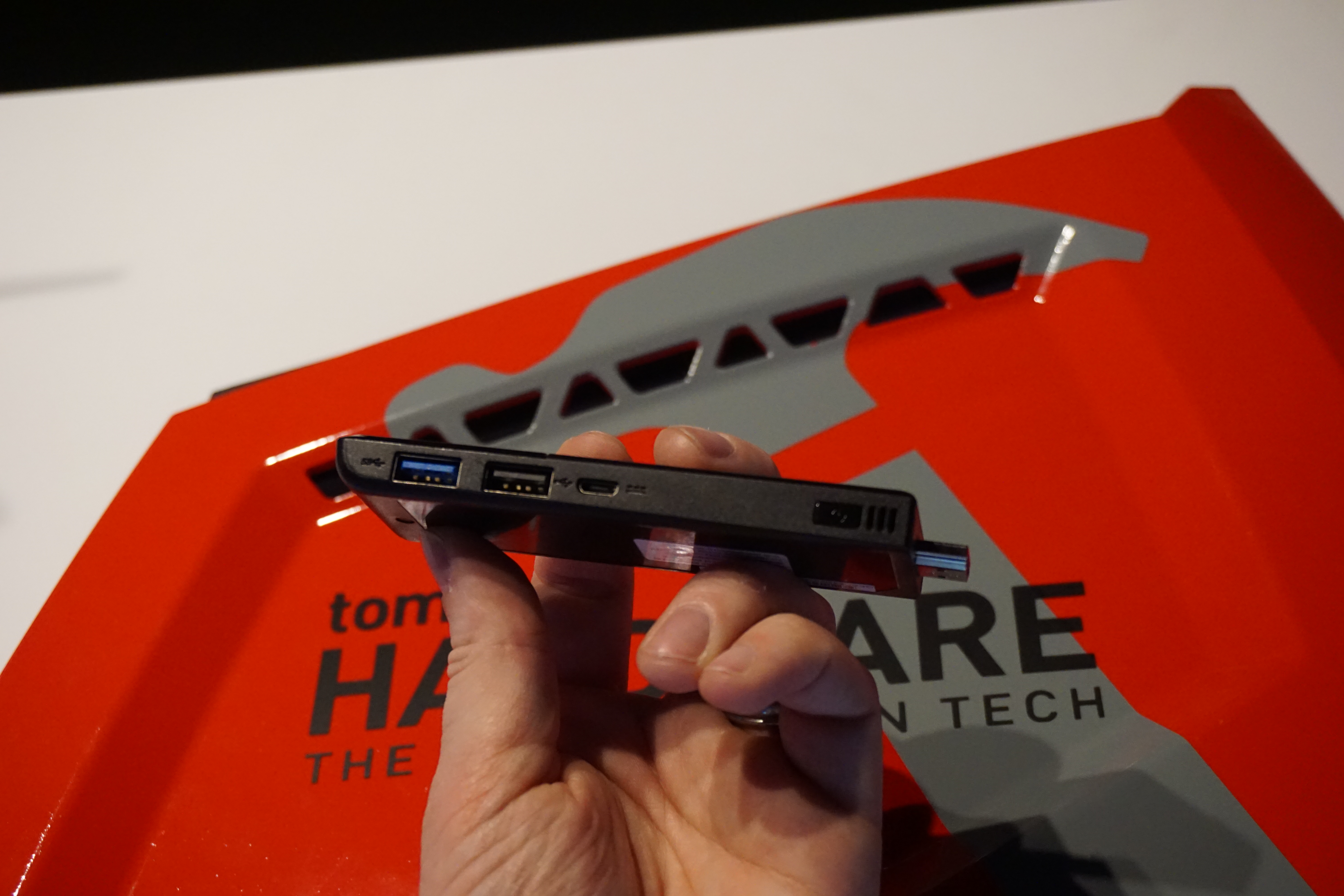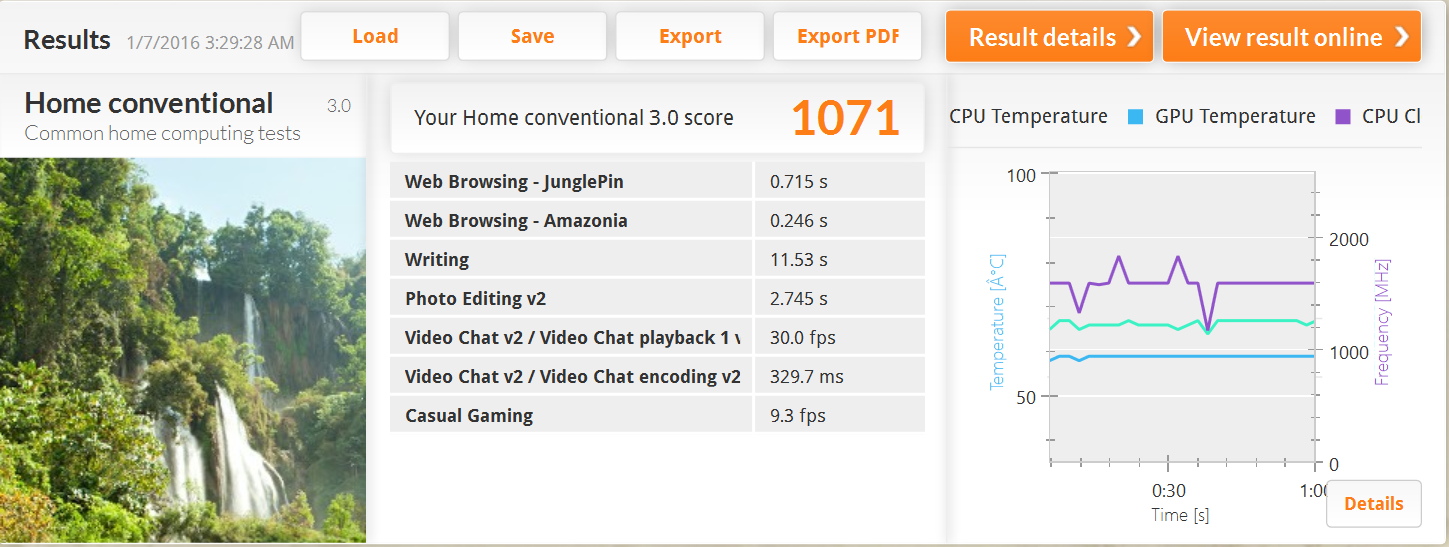First Benchmarks On Intel's New Atom-Based Compute Stick
Intel revealed a new Atom-powered Compute Stick at CES, and the company gave us a sample to take to the lab for review. However, we couldn’t wait to see what the new device could do, so we setup the Intel Compute Stick in our hotel room and fired up a few benchmarks to see how it would perform.
Technical Specs
| Operating System | Windows 10 |
|---|---|
| Processor | Intel Atom x5-Z8300 (Cherry Trail) |
| Graphics | Intel HD Graphics |
| Memory | 2 GB LPDDR3 |
| Storage | 32 GB eMMC storage |
| Ports | 1 USB 3.0, 1 USB 2.0, 1 microSD card slot |
| Networking | 802.11ac (Intel 7265) Dual-Band Wireless AC with Bluetooth 4.0 |
The Intel Compute Stick (PPSTK1AW32SC) features the new Intel Atom x5-Z8300 (Cherry Trail) quad core processor clocked at 1.44 GHz (with a burst frequency of 1.84 GHz), Intel HD Graphics, 2 GB of LPDDR3 onboard and 32 GB of eMMC storage. The device has one USB 3.0 and one USB 2.0 port in addition to a microSD card slot to connect your peripherals or for additional storage. The networking capabilities have also been improved with 2 x 2 antenna dual-band 802.11ac wireless, compared to the original's wireless-N technology.
Another First Impression
When we reviewed the original Intel Compute Stick, our first impression was that the device had a rightful place in the living room, being that it seemed forever tethered to the back of a display using an HDMI port and a power adapter. Not much has changed in that respect, but several features have been improved, and it's worth taking another look at Intel's Atom-powered Compute Stick.
Preliminary Benchmarks
Although we didn’t have our full benchmark suite on-hand (nor the time to dive that deep into this new product), we decided to run a few synthetic tests. For this, we used Futuremark’s 3DMark and PCMark 8. At first, I had my doubts the tiny device could handle the likes of such benchmarking software, but I was pleasantly surprised to find that the tests loaded and ran without issue (well, almost all of the tests; more on that later).
3DMark Results
Running 3DMark’s mobile-oriented graphics test, Ice Storm Extreme, we were able to attain an impressive score of 13720, with frame rates peaking as high as 84.64 fps with the occasional dip below 10 fps when heavy physics were at play. Although this particular benchmark is designed to test mainstream mobile devices, 3DMark Ice Storm Extreme presented the Intel Compute Stick with a decent graphic workload at 1080p, and it performed quite admirably.
We even tried to push it a little further by testing out the Cloud Gate benchmark (designed for mainstream desktops), but after watching the Intel Compute Stick struggle to break 10 fps, we cancelled the test, realizing this was out of the device’s performance reach. However, when presented with a test relative to the device’s hardware, the Intel Compute Stick seemed to provide a decent amount graphics horsepower for an Intel HD Graphics iGPU. Just don’t expect to game on it as a steam box alternative.
Get Tom's Hardware's best news and in-depth reviews, straight to your inbox.
PCMark 8 Results
We decided to run two different PCMark 8 tests: the Home and Work benchmarks. Each test was performed on the conventional settings without using OpenGL acceleration. The results also seem more on point with the level of hardware in the system than the graphics tests.
The Home benchmark seemed to take longer than estimated, but offered decent performance given the hardware. These scores are nowhere near what you would find in an entry-level desktop, but this is also likely the furthest PC product from a desktop.
The Work benchmark also seemed to struggle, taking much more time to complete than the program estimated. However, the scores were decent, again, given the hardware and also seemed to handle everything but graphics-intensive computing sufficiently for the intended use of the device.
We attempted to run the PCMark storage benchmark, but the device kept failing the test prematurely due to an error. This could be due to the eMMC storage or perhaps an incompatibility with the program, but either way, we were unable to get a clear idea of how fast the storage really is. If we had to judge the storage capabilities based on perceived load times, it doesn’t seem anywhere near as fast as a mainstream desktop, but it isn’t exactly slow either.
Time Will Tell
Until we get this to the lab and run our full benchmark suite, it’s difficult to compare performance of this new product to the previous generation of the Intel Compute Stick. However, judging from the few synthetic tests we did run, the new Atom-based compute stick offers decent horsepower for everyday computing, with a possibility for light gaming, so long as the 3D effects aren’t taxing.
The Atom-based Intel Compute Stick will be available at an MSRP of $159, but we don’t know how soon we will see it in stores.
Derek Forrest is an Associate Contributing Writer for Tom’s Hardware and Tom’s IT Pro. Follow Derek Forrest on Twitter. Follow us on Facebook, Google+, RSS, Twitter and YouTube.
Derek Forrest was a contributing freelance writer for Tom's Hardware. He covered hardware news and reviews, focusing on gaming desktops and laptops.
-
nitrium I'm a lot more interested in the also announced Core M versions of the Compute Stick.Reply
http://arstechnica.com/gadgets/2016/01/intels-new-atom-and-core-m-compute-sticks-get-faster-and-look-better/ -
alidan a nice emulation box, considering a raspberry pi but i want to be guaranteed through nd6 and ps1 before i jump on something.Reply -
JimmiG Not that great value to be honest. Atom-based Windows 10 tablets with quad-core and 2GB of RAM can be had for that much, and they come with a touch screen and other niceties.Reply -
Willyfisch You benchmark compute sticks but won't review Carrizo, which is a new x86 CPU arch and SOC.Reply
Well, I guess it's obvious where your money comes from... -
RedJaron Reply
If you are going to accuse the writers of taking money from Intel, AMD, NVidia, or any other manufacturer or vendor for favorable reviews, I suggest you present evidence of such. Otherwise we take that as a serious insult to the writers and staff at Tom's Hardware.17303976 said:You benchmark compute sticks but won't review Carrizo, which is a new x86 CPU arch and SOC.
Well, I guess it's obvious where your money comes from...
Tom's can only bench and review the hardware they have. That means they're limited by what vendors and mfrs will send in. Intel made these compute sticks available at CES. As it says at the top of the article, these were tests run in the hotel room.
Tom's ran a lengthy article at Carrizo's launch. If they haven't reviewed one yet, it's because more than likely they haven't had one made available for them. Even in the prelaunch news, OEMs said a lot of their demo laptop models with Carrizo wouldn't make it to market. -
GreetingsEarthling ReplyNot that great value to be honest. Atom-based Windows 10 tablets with quad-core and 2GB of RAM can be had for that much, and they come with a touch screen and other niceties.
The advantage is that it has no large battery that will eventually die and cripple the device. This could last a long time. (I have and like a WinBook Atom-based tablet, but it actually loses charge while plugged in if the screen is on.)
This looks like a solid iteration, the previous generation (Atom Z3735) scored between 9000-10000 on Ice Storm Extreme I believe.
-
RedJaron I wouldn't be surprised if some businesses used these as thin clients. A monitor with HDMI input and a built-in USB hub makes this an AIO system.Reply




